Tag:power=pole/Gallery
Generally the decision between a power=tower and a power=pole is based on the power line the tower carries ( power=line and power=minor_line, respectively), but sometimes these examples of the towers and poles might be of help.
-
 A typical power tower of steel lattice.
A typical power tower of steel lattice. -
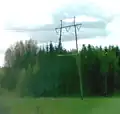 A bit smaller power tower with wooden vertical parts. High voltage, as seen from the insulators.
A bit smaller power tower with wooden vertical parts. High voltage, as seen from the insulators. -
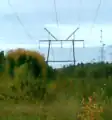 Another, yet a bit different. High voltage, as seen from the insulators.
Another, yet a bit different. High voltage, as seen from the insulators. -
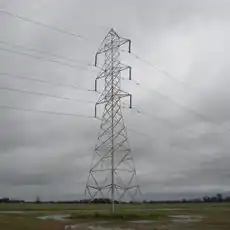 A typical steel lattice power tower carrying a dual-circuit 230 kV / 60 Hz power line.
A typical steel lattice power tower carrying a dual-circuit 230 kV / 60 Hz power line. -
 Steel lattice power towers carrying single-circuit and dual-circuit 115 kV / 60 Hz power lines.
Steel lattice power towers carrying single-circuit and dual-circuit 115 kV / 60 Hz power lines. -
A high voltage line tower with a staple shape structure.
-
 A narrower-than-usual tower carrying a 110 kV line - tower fits on a highway median.
A narrower-than-usual tower carrying a 110 kV line - tower fits on a highway median.
-
 Typical Finnish 20 kV line (topmost), a transformer and the resulting 400 V line.
Typical Finnish 20 kV line (topmost), a transformer and the resulting 400 V line. -
 A branching minor_line, same voltage in all directions?
A branching minor_line, same voltage in all directions? -
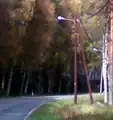 A typical wooden pole in a curve, vertical pole with a diagonal support pole.
A typical wooden pole in a curve, vertical pole with a diagonal support pole. -
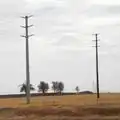 60 kV line using mostly wooden poles but also steel poles whenever there is a slight turn.
60 kV line using mostly wooden poles but also steel poles whenever there is a slight turn. -
 The most typical pole in rural areas.
The most typical pole in rural areas. -
 Simple wooden poles carrying 60 kV and 12 kV 60 Hz circuits and two ground wires.
Simple wooden poles carrying 60 kV and 12 kV 60 Hz circuits and two ground wires. -
 A guyed wooden pole rated at 115 kV / 60 Hz.
A guyed wooden pole rated at 115 kV / 60 Hz.
Examples of features where the classification might not be immediately obvious:
-
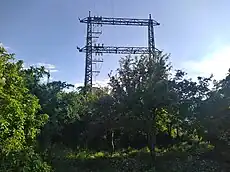 An untypical power=tower right next to a power plant. Not very high voltage, as seen from the insulators.
An untypical power=tower right next to a power plant. Not very high voltage, as seen from the insulators. -
 A variety of power lines (230/115/60/12 kV).
A variety of power lines (230/115/60/12 kV). -
 A SMUD dual-circuit 230 kV line on tubular steel poles.
A SMUD dual-circuit 230 kV line on tubular steel poles. -
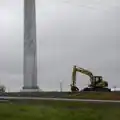 The base of a large tubular steel power pole for a 230 kV / 60 Hz power line under construction.
The base of a large tubular steel power pole for a 230 kV / 60 Hz power line under construction. -
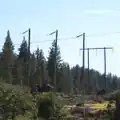 On older power lines with wooden towers, bends are often constructed this way, especially at high altitudes: each cable is carried on a separate guyed pole (in the background, a regular two-legged tower). Since the entire power line is mapped as a single way (with cables=3), I tagged the trio of poles as a single tower, not as three separate poles.
On older power lines with wooden towers, bends are often constructed this way, especially at high altitudes: each cable is carried on a separate guyed pole (in the background, a regular two-legged tower). Since the entire power line is mapped as a single way (with cables=3), I tagged the trio of poles as a single tower, not as three separate poles.